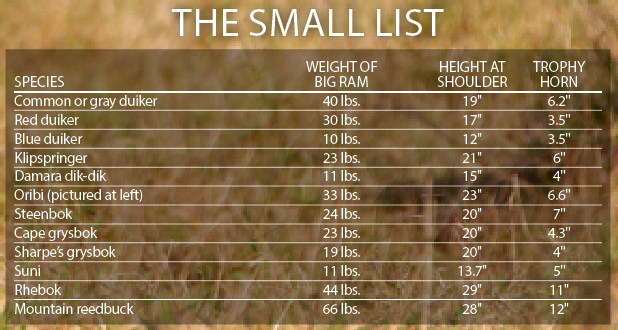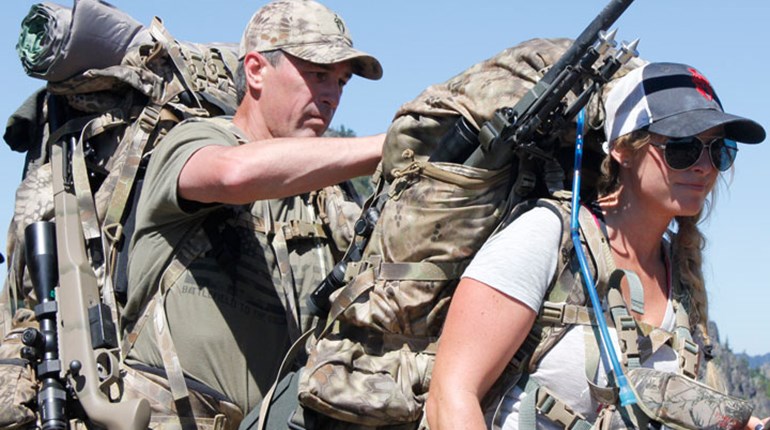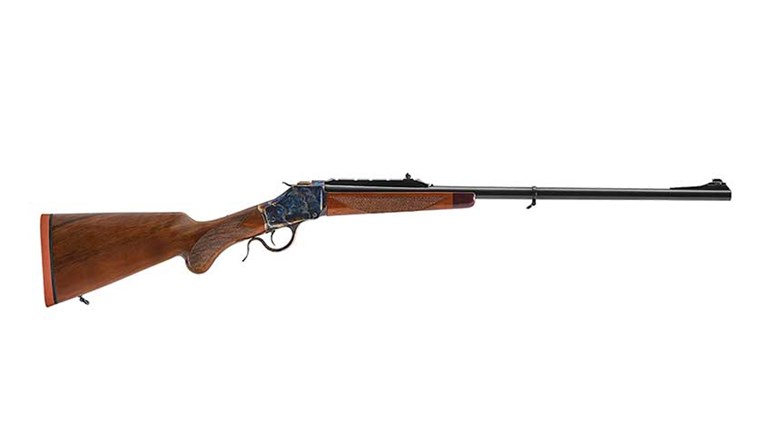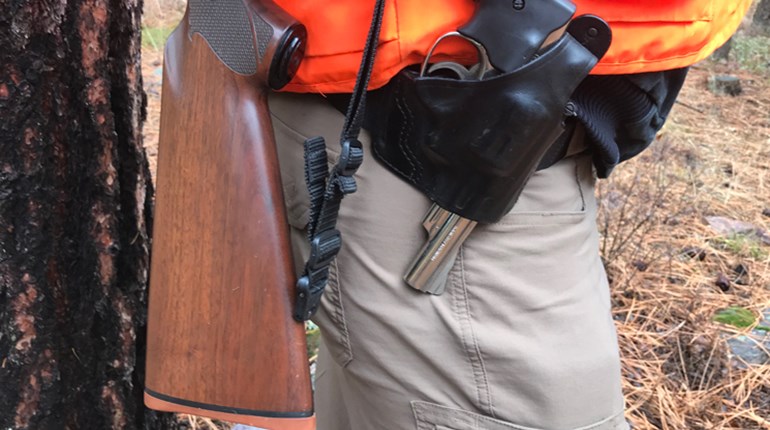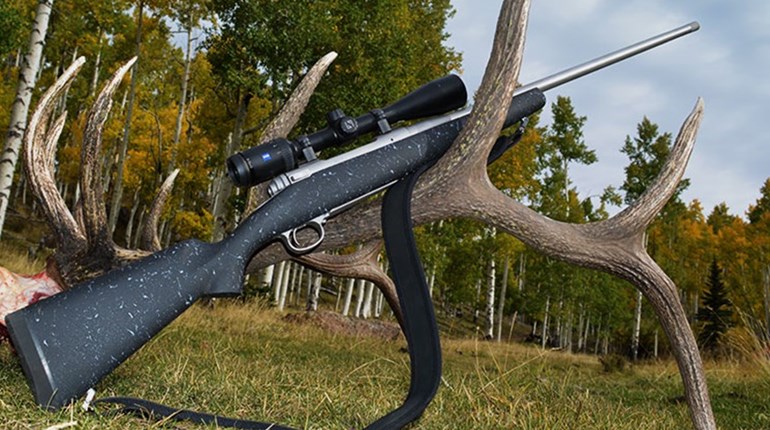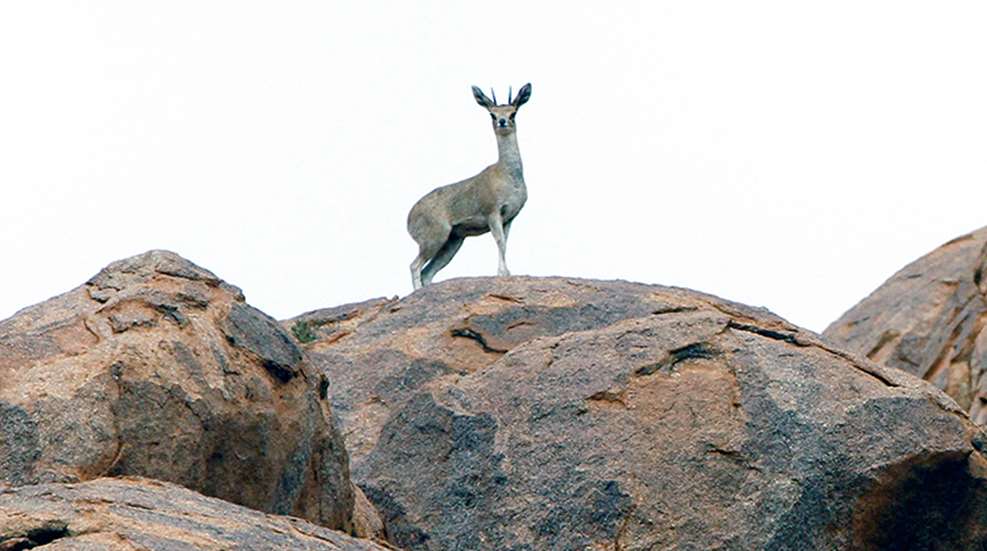
“Use enough gun” became a maxim in 20th century African hunting. Given the bullets of that time, the advice was good for ensuring success on large, tough game. But for much African antelope hunting today, better advice might be to “use a small enough gun (cartridge).”
“Just shoot it in the middle,” my Namibian guide recommended when I questioned the explosive potential of my Jarrett custom rifle in 7mm-08 Remington on our quarry. The 140-grain Swift A-Frame bullets I was shooting at 2840 fps had proven more than adequate for kudu, gemsbok and blue wildebeest, but those were all bulky, hardy species weighing more than 500 pounds each. We were now in pursuit of a darting, dashing Damara dik-dik, one of Africa’s famous “tiny 10” beasts of the hidden places. A big male might weigh 12 pounds dripping wet after a force-feeding. A .22 rimfire seemed more appropriate than a .308 Winchester necked down to .284. But we didn’t have a .22 rimfire, and my .300 Win. Mag. stuffed with 180-grain Barnes TSX bullets struck me as a worse option than the 7mm-08.
“The middle, huh?” I asked skeptically while fingering one of my handloads.
“Sure,” the PH insisted. “That leaves the shoulders and cape in perfect condition, and if you want a full-body mount, your taxidermist can sew up the middle and put it against a log or rock or something.”
That sounded rather speculative, but I probably wouldn’t spring for a full-body mount anyway, so I set my sights on the suggested paunch shot.
Our quarry, limited in range to a rather narrow strip of dry, rocky Namibian scrub/desert habitat, was surprisingly abundant on the ranch we were scouring south of Etosha National Park. The sprightly little animals darted through the grass like jackrabbits, ducked under shrubs like cottontails and stared with oversized eyes like hidden owls as we drove down the ranch lanes. After a dozen sightings I learned to ignore the long tuft of dark hairs between their ears and scan more intently for their short, dark horns—all 2 or 3 inches of them.
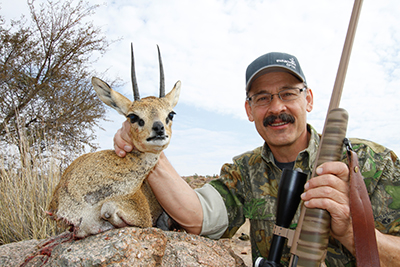 “There’s a good one,” my PH pronounced as a stump-horned little ram dashed off through the brush. And “That’s a hell of a ram!” as another darted through the grass. After three days I was both recognizing and appreciating the relative trophy qualities of these diminutive antelope. So it was I stalked with confidence after spotting a dark-horned male prodding a reluctant ewe and chasing her down a dry wash. I followed—and spooked him again. Then I lost him in the windings of another dry wash. Fortunately, his romantic interests inspired him to return to investigate another ewe, and that’s when I whistled. He stopped, the Swarovski reticle settled and the 7mm bullet flew true.
“There’s a good one,” my PH pronounced as a stump-horned little ram dashed off through the brush. And “That’s a hell of a ram!” as another darted through the grass. After three days I was both recognizing and appreciating the relative trophy qualities of these diminutive antelope. So it was I stalked with confidence after spotting a dark-horned male prodding a reluctant ewe and chasing her down a dry wash. I followed—and spooked him again. Then I lost him in the windings of another dry wash. Fortunately, his romantic interests inspired him to return to investigate another ewe, and that’s when I whistled. He stopped, the Swarovski reticle settled and the 7mm bullet flew true.
Start sewing. The 7mm-08 Remington is too much gun for a dik-dik.
Tiny antelope have long been an afterthought in African hunting, delightful distractions during pursuit of 2,000-pound eland and 600-pound kudu; dangerous distractions when stalking elephant, buffalo, leopard or lion. A 10- to 60-pound antelope exploding from the grass while you’re stalking a wounded buffalo could kill you by heart attack alone. Never mind taking your eyes and thoughts off your bigger quarry.
Because shooting a small antelope with too much gun is wiser than shooting dangerous game with too little gun, a light rifle to carry specifically for 10- to 60-pound antelope has never been high on hunters’ must-have lists. Maybe it should be.
In today’s safari market, small antelope—at least the more common species—are considerably more affordable than most of the big stuff. Sometimes they’re more abundant. Always they’re fascinating adjuncts to any hunt. A dik-dik mount can stimulate more conversation and more discussion about game, survival, hunting, habitat, evolution, species diversity, etc., than the biggest hippo or buffalo. Whether you’re springing for a buffalo, kudu, eland, oryx, sable or nyala, adding duikers, steenbok and suni to your bag gives you more bang for your safari buck. Hitting them, it can be argued, is a bigger challenge than plunking a round into the vitals of a 700-pound waterbuck, too.
Variety is the Spice of Antelope
Depending on how you split your taxonomy, southern Africa alone has 10 or 12 small antelope. We’ll arbitrarily set the upper weight limit for our category at 80 pounds. That leaves us with the list of candidates below. Relative dimensions can vary considerably by region so take them with a few grains of salt.
One could throw the lovely springbok into the mix, though a big ram will push 90 pounds, slightly less than our Coues whitetail. The common, graceful impala breaks 120 pounds, slightly more than a prime Wyoming pronghorn buck and more like a Midwest whitetail doe. To give further perspective, a big, North Dakota white-tailed jackrabbit can gorge itself to 10 pounds, the same as a blue duiker or average Damara dik-dik.
Tiny antelope indeed. Ecologically they fill roles similar to those of rabbits and hares, surviving on limited vegetation that larger beasts drop or don’t bother to find. A dik-dik’s nose/mouth, for example, is almost prehensile, bending left and right like a short trunk to pull tidbits of leaves from between the thorns. Red duikers’ narrow noses and short statures enable them to slip through brush and briars that would stymie larger animals. Steenboks live alone unless mating, defend territories against all comers and lie flat to avoid detection until practically stepped on.
These similarities to hares aren’t lost on local hunters. African wildcats, caracals, jackals, eagles, honey badgers and humans stalk, snare and eat small antelope much the way North American predators prey on rabbits and hares. Small prey species are often a larger percentage of local biomass than big stuff. Why pass them up? There’s currently a theory that Neanderthals died out while Homo sapiens thrived because the former couldn’t adapt to catching rabbits instead of the declining herds of bison and mastodons. Smart hunters take advantage of small mammals.
Tiny Tales
“Now there’s a big klippy,” my South African guide, John Wambach, said. That was enough to set me jogging for the distant, red sandstone cliffs and boulders this 22-pound, rock-hopping antelope calls home. Klipspringers walk and run on the very tips of their hooves, which feel more like chunks of truck tire than animal hoof—all the better for sticking to steep, rocky surfaces. Like so many of the tiny antelope, klipspringers live as mated pairs, defending their territories against others of their species rather than roaming in herds. They scent-mark their territories via large, preorbital glands and use their little spike horns to defend that ground. A 6-inch klipspringer horn is a great one, and anything over 5 inches earns both its wearer and the hunter who bags it bragging rights. This one appeared to be well over 5 inches.
“There he is,” my PH said after we’d reached the jumble of giant boulders into which our quarry had disappeared. “Standing on top of that big rock just below that bush. He’s spectacular. Take him first chance you get.” I’d just gotten the ram in my scope when he wheeled and dived behind his lookout post.
“Just a second too slow,” Wambach groaned. But I wasn’t done yet. I’d heard that klipspringers, again like many territorial antelope, can be lured into view with a nasal cry, a small bleat.
“I’ll try calling him out,” I said. “Let me know if he pops up.”
I settled my H-S Precision 7mm Rem. Mag. (too much gun!) onto my Steady Sticks bipod, chambered a round, rested my elbow on my knees, pinched my nose and bleated like a baby goat.
“There he is, just behind and to the left of where he disappeared.”
I found the ram, swung the Swarovski to cover him, reconfirmed the long horns, put the reticle on his brisket and ended a 15-year, off-and-on quest for my big klipspringer, a 22-pound ram with long, slim horns protruding well above his ears.
Not all hunts take so long. My mountain reedbuck hunt ended with the first ram I’d ever seen. We were in the highlands near the headwaters of the White and Black Umfolozi Rivers in the Natal Province, driving higher in search of both the mountain reedbuck and much larger, more dramatic nyala when our tracker spotted a small, gray ram bounding up a grassy hillside. We jumped from the truck, skirted a small knob and relocated the animal.
“Ram. Nice one. Take him if you can,” my PH said.
A single 180-grain Speer Grand Slam from my .300 Win. Mag. flew true and the 65-pound reedbuck, one of the larger “small” antelope, rolled lightly down the slope. Need I mention that the .300 Win. Mag. was more than enough gun?
In subsequent years I would hunt more of these herding animals with Crusader Safaris in the dramatic hills and ridges of the Winterberg Mountains of South Africa. Small clusters of ewes were usually followed by one boss ram and a young upstart or two. Older rams, pushed out by those up-and-coming youngsters, would wander alone, their forward curving horns still fat, if somewhat blunted by too many years of hard fighting. My wife took one of these after a long uphill stalk on a rainy day but not as rainy as the one on which I took my best gray duiker.
Here is another 40-pound antelope that can frustrate the collector. Widespread across southern Africa, it is so abundant and familiar that it’s known as the common duiker. Long horns may not be so common. During more than a dozen safaris I must have flushed, spotted and stalked dozens of common duikers without so much as glimpsing tall horns until an unusually rainy day in the Baviaans River Conservancy in the Eastern Cape.
A veteran guide with Crusader Safaris lured me into the rain with tales of a large common duiker ram he often saw at last light. We glassed three dark forms emerging from riverine brush in the waning light, slipped through scattered brush, confirmed tall horns and dropped the old ram with a single shot from a T/C Dimension bolt-action spitting Hornady 162-grain SST loads. Without the 50mm objective Zeiss scope atop that borrowed rifle, I doubt I could have made the shot. Yes, the 7mm is too much gun for a duiker.
And so the small antelope stories go. Everyone who has ever enjoyed a safari has tiny tales that spice up fireside conversations and often steal the show. Long after the buffalo and man-eating crocs are laid to rest, Africa’s little antelope sneak out to enliven our memories and contribute mightily to the mystique and allure that is Africa hunting. Don’t miss your tiny antelope chances. And, if possible, use a small enough gun.
